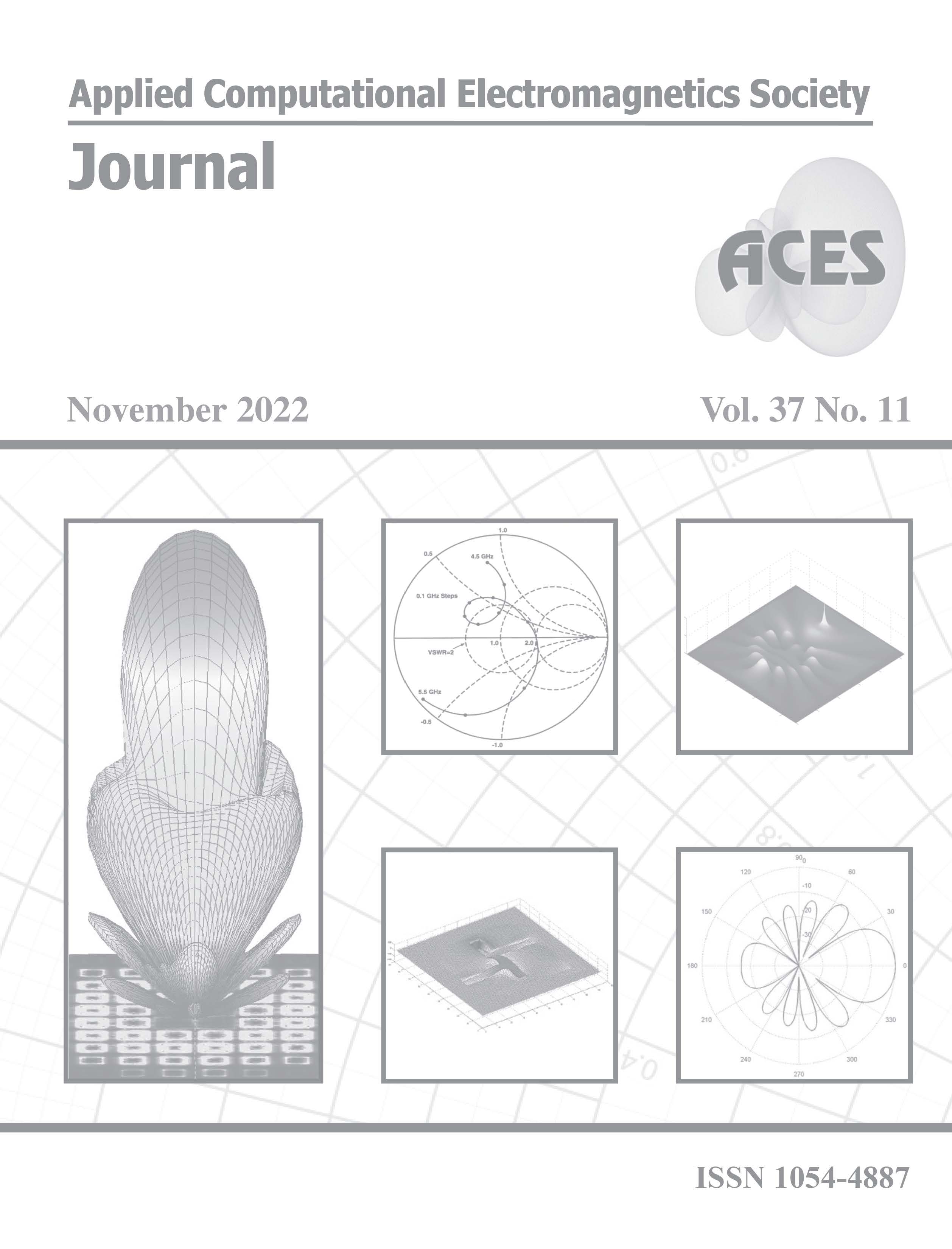Non-Destructive Detection of Pipe Line Cracks Using Ultra Wide Band Antenna with Machine Learning Algorithm
##plugins.pubIds.doi.readerDisplayName##:
https://doi.org/10.13052/2022.ACES.J.371103关键词:
crack detection, Machine Learning, pulse characteristics, UWB antenna摘要
In this article, an Ultra-Wide Band (UWB) antenna for the pipeline crack detection process is proposed. A UWB antenna has been designed with the dimension of 32 x 32 mm2 and it resonates from 3 GHz to 10.8 GHz. The designed antenna produces a peak gain of 4.36 dB. A pair of UWB antennas are employed in various pipeline scenarios and the received pulse from antenna 1 to antenna 2 is used for further processing and detection of pipeline cracks. Through the suitable machine learning data classifier algorithm the dimension of the crack has been detected. The various features such as mean, standard deviation (σ), mean average deviation (mad), skewness, and kurtosis have been extracted from the received pulse. Then the three different machine learning algorithms namely Support Vector Machine (SVM), k-Nearest Neighbor (kNN), and Naïve Bayse (NB) were trained and tested using extracted features, and the dimension of the void has been identified. Out of these three machine learning algorithms, kNN provides better accuracy and precision. It predicts the small cracks with 100% accuracy having a dimension as small as 1 mm width.
##plugins.generic.usageStats.downloads##
参考
A. Jaganathan, E. Allouche, and S. Neven, “Numerical modeling and experimental evaluation of a time domain UWB technique for soil void detection,” Tunnelling and Underground Space Technology, vol. 25, pp. 652-659, 2010.
H. Andre, P. Emeraldi, R. Fernandez, M. Muharam, Firdaus, and E. P. Waldi, “Triple band circular microstrip antenna for metallic material crack sensing,” International Conference on Applied Science and Technology, Manado, Indonesia, pp. 373- 374, 2019.
X. R. Wang, X. B. Wang, H. Ren, N. S. Wu, J. W. Wu, W. M. Su, Y. L. Han, and S. Xu “Optically transparent microwave shielding hybrid film composited by metal mesh and graphene,” Progress In Electromagnetics Research, vol. 170, pp. 187-197, 2021.
M. Moosazadeh, S. Kharkovsky, J. T. Case, and B. Samali, “Miniaturized UWB antipodal vivaldi antenna and its application for detection of void inside concrete specimens,” IEEE Antennas and Wireless Propagation Letters, vol. 16, pp. 1317-1320, 2016.
C. Wang, C. Wang, G. C. Wan, M. S. Tong, S. Guan, and L. Y. Xie, “RFID antenna sensor for quantitatively monitoring surface crack growth,” IEEE International Conference on Computational Electromagnetics (ICCEM), Shanghai, China, pp. 1-3, 2019.
C. Y. Yeh and R. Zoughi, “A novel microwave method for detection of long surface cracks in metals,” IEEE Transactions on Instrumentation and Measurement, vol. 43, no. 5, pp. 719-725, Oct. 1994.
J. Kerouedan, P. Quéffélec, P. Talbot, C. Quendo, S. De Blasi, and A. Le Brun, “Detection of micro-cracks on metal surfaces using near-field microwave dual-behavior resonator filters,” Measurement Science and Technology, vol. 19, no. 10, 2008.
A. M. Albishi, M. S. Boybay, and O. M. Ramahi, “Complementary split-ring resonator for crack detection in metallic surfaces,” IEEE Microwave and Wireless Components Letters, vol. 22, no. 6, pp. 330-332, 2012.
M. H. Zarifi, S. Deif, M. Abdolrazzaghi, B. Chen, D. Ramsawak, M. Amyotte, N. Vahabisani, Z. Hashisho, W. Chen, and M. Daneshmand, “A microwave ring resonator sensor for early detection of breaches in pipeline coatings,” IEEE Transactions on Industrial Electronics, vol. 65, no. 2, pp. 1626-1635, 2018.
A. M. Albishi and O. M. Ramahi, “Surface crack detection in metallic materials using sensitive microwave-based sensors,” IEEE 17th Annual Wireless and Microwave Technology Conference (WAMICON), pp. 1-3, 2016.
C. L. Bennett and G. F. Ross, “Time-domain electromagnetics and its applications,” Proceedings of the IEEE, vol. 66, no. 3, pp. 299-318, 1978, doi: 10.1109/PROC.1978.10902.
S. Mohandoss, S. K. Palaniswamy, R. R. Thipparaju, M. Kanagasabai, B. R. B. Naga, and S. Kumar, “On the bending and time domain analysis of compact wideband flexible monopole antennas,” International Journal of Electronics and Communications, vol. 101, pp. 168-181, 2019.
S. R. Zahran, M. A. Abdalla, and A. Gaafar, “Time domain analysis for foldable thin UWB monopole antenna,” International Journal of Electronics and Communications, vol. 83, pp. 253-262, 2018.
Y. Rahayu, T. A. Rahman, R. Ngah, and P. S. Hall, “Ultrawide band technology and its applications,” International Conference on Wireless and Optical Communications Network, Surbaya, pp. 1-5,2008.
M. Bozorgi and A. Tavakoli, “Polarimetric scattering from a 3-D rectangular crack in a PEC covered by a dielectric layer,” American Computation Electromagnetics Society (ACES) Journal, vol. 26, no. 6, pp. 502-511, 2022.
X. Han, H. Li, Y. Zhou, L. Wang, S. Liang, and F. Javaid “An elliptically polarized wave injection technique via TF/SF boundary in subdomain level DGTD method,” Progress in Electromagnetics Research, vol. 175, pp. 13-27, 2022.
A. Mirala and R. Sarraf Shiraz, “Detection of surface cracks in metals using time domain microwave non-destructive testing,” IET Microwaves, Antennas & Propagation, vol. 11, pp. 564-569, 2017.
W. Saadat, S. A. Raurale, G. A. Conway, and J. McAllister, “Wearable antennas for human identification at 2.45 GHz,” IEEE Transactions on Antennas and Propagation, vol. 70, no. 1, pp. 17-26, 2022.
X. He and T. Jiang, “Target identification in foliage environment using UWB radar with hybrid wavelet-ICA and SVM Method,” Physical Communication, vol. 1, pp. 197-204, 2014.
J. P. Uwiringiyimana, U. Khayam, Suwarno, and G. C. Montanari, “Design and implementation of ultra-wide band antenna for partial discharge detection in high voltage power equipment,” IEEE Access, vol. 10, pp. 10983-10994, 2022.
E. Zhou, Y. Cheng, F. Chen, H. Luo, and X. Li, “Low-profile high-gain wideband multi-resonance microstrip-fed slot antenna with anisotropic meta surface,” Progress in Electromagnetics Research, vol. 175, pp. 91-104, 2022.
F. Jiang, S. Liu, and L. Tao, “Quantitative research on cracks in pipe based on magnetic field response method of eddy current testing,” American Computation Electromagnetics Society (ACES) Journal, vol. 36, no. 1, pp. 99-107, 2021.
F. Deek and M. E. Shenawee, “Microwave detection of cracks in buried pipes using the complex frequency technique,” American Computation Electromagnetics Society (ACES) Journal, vol. 25, no. 10, pp. 894-902, 2010.




